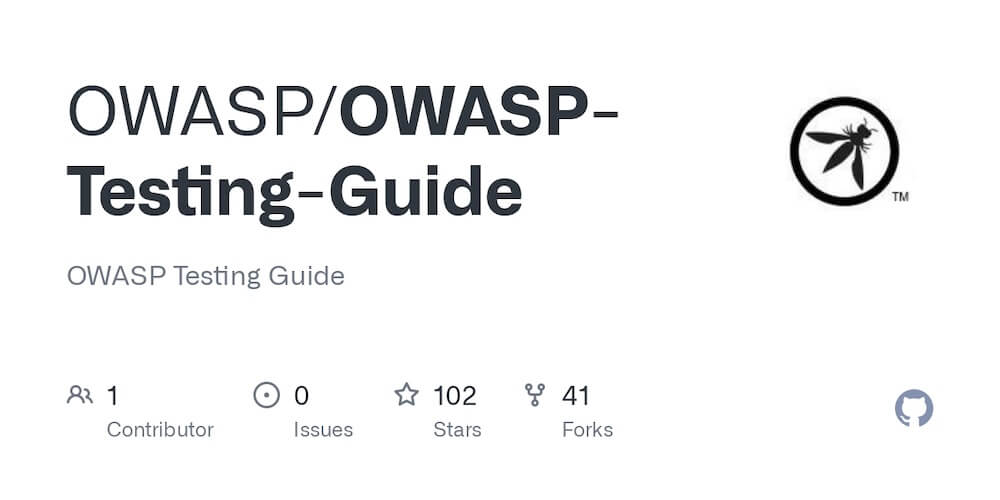· Alex · security · 12 min read
Unraveling the OWASP Web Security Testing Guide
The 4 phases of the OWASPs Testing Guide and key testing techniques

OWASP Testing Guide
Purpose of the OWASP Testing Guide
This handy document is designed to help you identify vulnerabilities in your web applications by providing a systematic and comprehensive approach to web application security testing. In other words, it’s your roadmap to discovering and fixing security weaknesses before attackers can exploit them. The Testing Guide is more than just a list of tests to perform; it’s a framework that outlines the entire security testing process. The guide is updated periodically to keep up with the latest threats and best practices, making it a must-have resource for anyone serious about web application security testing.
The goals and objectives of the guide are pretty straightforward: provide a comprehensive methodology for security testing, offer clear and concise instructions on how to perform tests, and promote consistent and repeatable security testing practices.
The Four Phases of the OWASP Testing Process
Phase 1: Planning and Preparation
Before you can get down to the nitty-gritty of testing, you need a solid plan. That’s what Phase 1 is all about. So, let’s take a look at the key steps involved in this phase:
Defining the scope of testing
First things first, you’ll need to define the scope of your testing. This means figuring out what exactly you’ll be testing, and just as importantly, what you won’t be testing. Are you testing a single web application, multiple applications, or specific components within an application? Consider things like the target audience, technologies used, and potential threats that may be relevant. A well-defined scope is crucial for staying focused and efficient throughout the testing process.
Engaging stakeholders
You can’t do it alone, so it’s essential to get your stakeholders involved from the get-go. These might include developers, project managers, security professionals, and even clients. By engaging these folks early on, you can make sure everyone’s on the same page and understands their roles and responsibilities. This will also help you get the support and resources you need to carry out your testing effectively.
Preparing the environment and tools
Last but not least, you’ll need to set up your testing environment and gather the tools you’ll be using. This can include creating a testing environment that mirrors the production environment as closely as possible, while also ensuring it’s isolated from the real thing to prevent any accidental damage. Next, you’ll want to choose the right tools for the job. The OWASP Testing Guide provides guidance on various tools, ranging from web proxies and scanners to fuzzers and vulnerability assessment tools. Make sure you’re familiar with these tools and how to use them before you dive into testing.
Phase 2: Information Gathering
Passive and active information gathering techniques
Information gathering can be broken down into two main categories: passive and active techniques. Passive techniques are all about collecting data without actually interacting with the target application.
Some passive techniques include reviewing publicly available information like WHOIS records, DNS information, and application documentation. You might also want to check out search engine caches, social media profiles, and even archived web pages.
On the flip side, active techniques involve directly engaging with the target application. This might include sending requests to the application, enumerating user accounts, or mapping out the application’s structure. Keep in mind that active techniques can be more intrusive and riskier, so make sure you’ve got the proper permissions and safeguards in place before you dive in.
Identifying entry points and attack surfaces
As you gather information, you’ll want to identify the application’s entry points and attack surfaces. Entry points are the various ways users can interact with the application, like login forms, search boxes, and file upload features. Attack surfaces are the parts of the application that could be vulnerable to exploitation, such as user input fields, cookies, or APIs. By identifying these elements, you can focus your testing efforts on the areas that are most likely to be targeted by attackers.
Documenting findings
Last but definitely not least, it’s crucial to document your findings throughout the information gathering process. You’ll want to keep track of things like application components, URLs, user roles, and potential vulnerabilities. Good documentation will not only help you stay organized but also provide a valuable resource for your testing efforts in the later phases. Plus, it makes it easier to share your findings with the rest of your team and ensure everyone’s on the same page.
Phase 3: Vulnerability Assessment
Vulnerability classification and prioritization
Before you start hunting for vulnerabilities, it’s a good idea to categorize and prioritize them. Vulnerability classification involves categorizing vulnerabilities based on factors like potential impact, exploitability, and affected components. This will help you stay organized and focused during testing. Prioritization, on the other hand, is all about figuring out which vulnerabilities to tackle first. You’ll want to prioritize vulnerabilities based on factors like risk, business impact, and the ease of exploitation.
Manual and automated testing methods
Now it’s time to start testing! There are two main approaches to vulnerability assessment: manual and automated testing. Manual testing involves hands-on testing by a human, using techniques like penetration testing, code review, and manual test case execution. This method is great for uncovering complex vulnerabilities and understanding the context of the application.
Automated testing, on the other hand, involves using tools to scan for vulnerabilities. This can include vulnerability scanners, static code analyzers, and dynamic testing tools. Automated testing is great for quickly identifying common vulnerabilities and covering a large scope. However, it’s important to remember that automated tools aren’t perfect and can sometimes produce false positives or negatives. Ideally, you’ll want to use a combination of manual and automated testing methods to ensure a thorough assessment of the target application.
Common web application vulnerabilities and corresponding OWASP testing techniques
There are countless vulnerabilities that could be lurking in a web application, but some are more common than others. Here are a few examples of common web application vulnerabilities, along with the corresponding OWASP testing techniques to help you identify them:
- SQL Injection: Test for SQL injection vulnerabilities by crafting malicious input that could manipulate an application’s SQL queries. The OWASP Testing Guide offers specific techniques for identifying and exploiting these vulnerabilities.
- Cross-site Scripting (XSS): Test for XSS vulnerabilities by injecting malicious scripts into input fields or URLs, aiming to execute the script in the user’s browser. The OWASP Testing Guide provides detailed instructions on testing for both stored and reflected XSS vulnerabilities.
- Insecure Authentication and Authorization: Test for weaknesses in authentication and authorization mechanisms, such as weak password policies, lack of multi-factor authentication, or improper access controls.
Phase 4: Reporting and Remediation
Reporting vulnerabilities to stakeholders
After all your hard work identifying vulnerabilities, it’s time to share your findings with the relevant stakeholders. This might include developers, project managers, or even clients. You’ll want to create a clear and concise report that details the vulnerabilities you’ve found, their potential impact, and any recommended remediation steps. When creating your report, make sure to include enough technical details to help the development team understand and address the vulnerabilities, but also provide a high-level summary for non-technical stakeholders. This will help ensure everyone has a clear understanding of the issues and can make informed decisions about how to move forward.
Developing and implementing remediation plans
With your report in hand, it’s time to work with your team to develop and implement a plan to remediate the vulnerabilities you’ve found. This might involve fixing insecure code, updating third-party libraries, or improving security policies and procedures. Be prepared to work closely with developers and other stakeholders to ensure they understand the vulnerabilities and the best way to address them. Keep in mind that remediation efforts should be prioritized based on the risk and impact of each vulnerability. Focus on fixing the most critical issues first, while keeping an eye on the potential impact of any changes on the application’s functionality and performance.
Retesting and verifying fixes
Once your team has implemented the remediation plan, it’s essential to retest the application to ensure the vulnerabilities have been successfully addressed. This might involve repeating the same tests you performed during the vulnerability assessment phase or using new tests to confirm the fixes are effective. Retesting is crucial for verifying that the vulnerabilities have been resolved and that no new issues have been introduced during the remediation process.
Key OWASP Testing Techniques
Input Validation Testing
Input validation is all about making sure that any data entered by users is properly checked and sanitized before it’s processed by the application. Failing to validate user input can lead to a variety of security vulnerabilities, like SQL Injection, Cross-site Scripting (XSS), and more. So, let’s take a look at some OWASP testing techniques for input validation:
SQL Injection, Cross-site Scripting (XSS), and other input validation vulnerabilities
Some common input validation vulnerabilities include SQL Injection and XSS, which we’ve briefly touched on earlier. There are, of course, other input validation vulnerabilities, such as XML External Entity (XXE) attacks, command injection, and more. The key takeaway is that proper input validation is crucial to prevent these types of vulnerabilities and keep your web application secure.
OWASP testing techniques for input validation
OWASP provides a wealth of testing techniques to help you identify input validation vulnerabilities. Some of these techniques include:
- Fuzzing: This involves sending a large volume of unexpected or malformed input to the application to see how it responds. Fuzzing can help you uncover hidden vulnerabilities, crashes, or other unexpected behavior that could indicate a security issue.
- Boundary testing: Focuses on testing inputs at the extreme ends of the allowed data ranges to see if the application can handle them correctly. This can help identify issues like buffer overflows or integer overflows, which could lead to more serious vulnerabilities.
- Injection testing: As the name suggests, this technique involves injecting malicious input into the application to see if it can be exploited. Be sure to craft injection payloads specific to the technologies used by the application to increase the likelihood of success.
Authentication and Authorization Testing
Next up in our exploration of key OWASP testing techniques is Authentication and Authorization Testing. This aspect of testing focuses on ensuring that the mechanisms for verifying user identities and controlling access to resources are robust and secure.
Weak authentication and authorization mechanisms
Authentication is the process of verifying a user’s identity, while authorization is all about determining what actions or resources a user is allowed to access. Weaknesses in these mechanisms can lead to a range of security issues, including unauthorized access to sensitive data, privilege escalation, or even full control over the application. Some examples of weak authentication and authorization mechanisms include:
- Weak password policies
- Lack of multi-factor authentication (MFA)
- Improper access controls
Session Management Testing
Session hijacking, fixation, and other session management vulnerabilities
Session management is all about maintaining a user’s state across multiple requests within a web application. Weaknesses in session management can lead to a variety of security issues, such as session hijacking, session fixation, or even unauthorized access to sensitive data.
OWASP testing techniques for session management
OWASP provides several testing techniques to help you identify and address weaknesses in your application’s session management mechanisms.
- Session token analysis: Evaluate the strength and randomness of session tokens by analyzing their structure, length, and entropy. Weak session tokens can make it easier for attackers to guess or brute-force valid tokens.
- Session handling testing: Test the application’s handling of sessions by attempting to reuse session tokens, manipulate session data, or access expired sessions. This can help identify issues like improper session termination or insecure storage of session data.
- Session fixation testing: Assess the application’s susceptibility to session fixation by attempting to force a user to use a specific session token or manipulate session tokens to gain unauthorized access.
Other Testing Techniques
Error handling, cryptography, and business logic testing
There are many facets to securing a web application, and these three areas are just a few more that deserve attention:
- Error handling: Proper error handling ensures that sensitive information is not leaked through error messages or application crashes. Insecure error handling can expose system information, user data, or even provide clues to potential vulnerabilities.
- Cryptography: Strong cryptography is essential for protecting sensitive data, both in transit and at rest. Weak or outdated cryptographic algorithms can make it easier for attackers to decrypt or tamper with data.
- Business logic: Business logic refers to the rules and processes that drive an application’s functionality. Flaws in business logic can lead to security vulnerabilities such as unauthorized actions, data manipulation, or fraud.
OWASP testing techniques for these areas
OWASP offers a variety of testing techniques to help you identify and address weaknesses in error handling, cryptography, and business logic. Some key techniques include:
- Error handling testing: Test the application’s error handling by intentionally triggering errors or causing the application to crash. Look for sensitive information leakage, generic error messages, or any indication of potential vulnerabilities.
- Cryptography testing: Evaluate the cryptographic algorithms and implementations used by the application. Check for weak algorithms, insecure key management, or known vulnerabilities in cryptographic libraries.
- Business logic testing: Assess the application’s business logic by attempting to perform actions that should be restricted or bypassing expected workflows. Look for issues like unauthorized access, data manipulation, or other unintended consequences.
Leveraging the OWASP Testing Guide for Your Organization
Incorporating the OWASP Testing Guide into your security testing processes
The OWASP Testing Guide is a valuable resource that can help improve your organization’s security posture. Here are some tips for incorporating the guide into your security testing processes:
Adapting the guide for your specific needs and requirements
While the OWASP Testing Guide provides a comprehensive framework for web application security testing, it’s important to remember that each organization is unique. To make the most of the guide, adapt it to suit your specific needs, requirements, and risk tolerance. This may involve prioritizing certain testing techniques based on your application’s technologies, focusing on areas of concern for your industry, or tailoring the guide to align with your organization’s security objectives.
Conclusion
The OWASP Testing Guide is a comprehensive resource that provides a framework for identifying and addressing vulnerabilities in web applications. By following the guide’s four-phase testing process and utilizing key OWASP testing techniques, you can significantly improve your application’s security posture, protect sensitive data, and prevent unauthorized access or attacks. To make the most of the OWASP Testing Guide, remember to adapt it to your organization’s specific needs and requirements, and integrate it with your existing security policies and procedures.
About the Author:
Application Security Engineer and Red-Teamer. Over 15 years of experience in Application Security, Software Engineering and Offensive Security. OSCE3 & OSCP Certified. CTF nerd.


